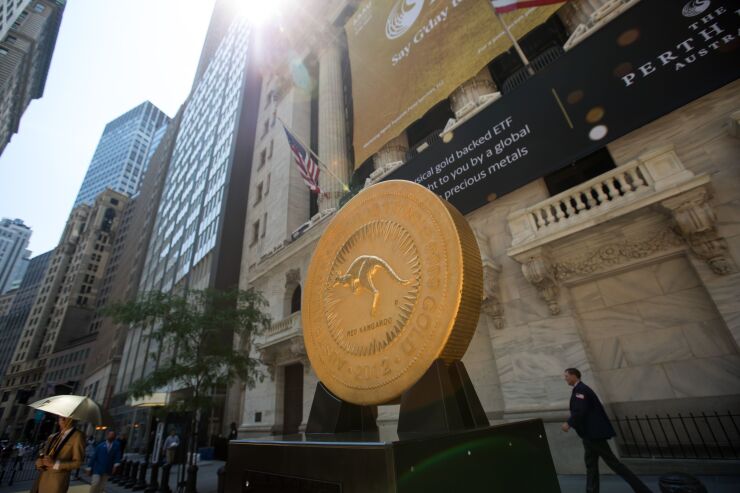The battle between mutual funds and exchange-traded funds is over. ETFs won.
It wasn’t easy. ETFs have been around for nearly three decades, and hardly anyone noticed for a long time. The first ETF, State Street’s SPDR S&P 500 ETF Trust, debuted in 1993. By the mid-2000s, there were roughly 350 ETFs, but the industry had gathered just $320 billion from investors from 1996 to 2006, according to Morningstar’s earliest available numbers.
Meanwhile, mutual funds scooped up close to $2.3 trillion during the same time, their ranks swelling to 6,500 funds at the end of 2006.

Indeed, the mutual fund industry was a formidable adversary when ETFs came along. It reliably generated tens of billions of dollars a year in fees, mostly from high-priced actively managed funds, so it was plenty motivated to keep the cash flowing.
It paraded its star managers to distract investors from
The next crash wasn’t as forgiving, and it gave ETFs their big break.
The financial crisis ripped through markets beginning in late 2007. Managers had few places to hide, and actively managed mutual funds took a beating. Disappointed investors started shopping around.
“There was a huge rush into passive investing,” Dave Nadig, director of research for ETF Trends, told me. “Investors flushed their overpriced benchmark-hugging active funds and reallocated to cheap and boring ones, having had their hands burned. They also took tax hits from decades’ old positions, either saying ‘enough is enough’ or booking actual tax losses.”
ETFs, with their stable of low-cost index funds that track broad markets, were perfectly positioned to give investors what they wanted. They took in an additional $300 billion in 2007 and 2008, and the money kept pouring in from there.
Investors have handed $4 trillion to ETFs since 2007 through August, compared with $1.6 trillion for mutual funds. And there are now more than 2,500 ETFs, while the number of mutual funds is down modestly to around 6,300 since 2006.
Looking back, it’s a wonder it took investors so long to discover ETFs. While they’re almost identical to mutual funds, ETFs differ in two ways that give them a demonstrable edge. One is cost. The median expense ratio for U.S.-based ETFs is 0.5% a year, compared with 0.93% across all share classes of mutual funds. The savings can add up to tens of thousands of dollars or more over an investing lifetime.
ETFs are also more tax efficient. When investors pull money from a mutual fund, the fund must sell some of its holdings to generate the necessary cash. If those holdings have appreciated in value, the fund’s remaining shareholders are stuck with the tax bill. ETFs, by contrast, trade like stocks — investors buy and sell ETFs from one another, so the fund isn’t involved and its investments undisturbed. (I’m referring to open-end mutual funds, which is what most investors own. Closed-end mutual funds trade like ETFs.)
Good luck getting in to see an estate planner if you don’t already have one. Cross your fingers if you do.
Trading like stocks has other advantages. ETFs trade all day, so investors see the price when they buy and sell. Mutual funds, on the other hand, are priced at the end of the day at the fund’s net asset value (NAV), or the value of its holdings at market close. Investors must therefore place trades without knowing the price, which can result in unwanted surprises on volatile days. Most mutual funds also impose minimum investments, whereas anyone can buy an ETF. Some brokers even allow investors to purchase fractional ETF shares, so they can get started with just a few dollars.
ETFs have some downsides, but they’re easy to navigate.
For one, ETFs typically don’t trade at NAV, so it’s possible to pay more than the fund’s underlying holdings are worth. Investors can manage that risk by choosing ETFs that closely hug their NAV, and most do. Roughly two-thirds of ETFs traded at an average premium to NAV of 0.1% or less during the past 12 months, and about a third of those traded at a discount.
Also, like all traders, ETF investors must make sure their trades are executed at or near the quoted price. The risk of an errant trade is exceedingly low for ETFs with a lot of trading volume. For thinly traded ETFs, investors can use limit orders to specify the least favorable price they’re willing to accept.
The COVID-19 sell-off last year further accelerated flows to ETFs. They’ve taken in close to $1.1 trillion since 2020 through August, compared with just $24 billion for mutual funds. And that lead is likely to widen.
ETFs have expanded their lineup since the financial crisis to include every conceivable style of investing — essentially, anything mutual funds can do, ETFs can now do more cheaply — and cryptocurrency ETFs are probably
In fact, mutual fund companies may be giving up. More of them are
Advisers are increasingly replacing mutual funds with ETFs in client portfolios. It’s an easy way to lower clients’ overall fees without having to cut their own. It’s also a way to appeal to younger investors who
Even so, mutual funds will be around for a while. There’s still more than $17 trillion in actively managed mutual funds, and fund companies are in no hurry to give up the more than $100 billion a year they generate in fees. There’s an additional $5 trillion in index mutual funds, most of which rival ETFs in cost, and mutual funds still dominate retirement plans such as 401(k)s.
But the future almost certainly belongs to ETFs. The decades-long era of expensive and underperforming mutual funds is ending, and not a moment too soon.







